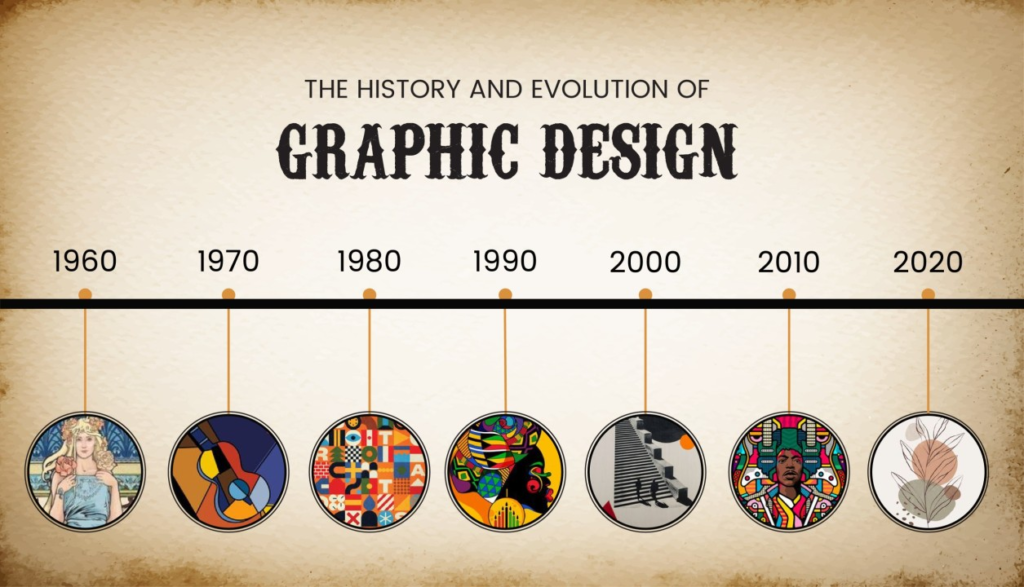Graphic design has undergone a remarkable evolution over the centuries, transforming from rudimentary artistic expression to a dynamic and influential industry shaping various aspects of our lives.
Table of contents
Graphic Design
Graphics , at its core, involves visual communication through the use of typography, images, and other visual elements to convey ideas or messages. Its evolution traces back to ancient times when humans communicated through symbols and drawings.

Evolution of Graphic Design:
Graphic Design Evolved Over Time as the genesis of graphic design lies in early human history, where cave paintings and hieroglyphs served as primitive forms of visual communication. As civilizations progressed, techniques like calligraphy and illuminated manuscripts emerged, setting the foundation for visual artistry.

Impact of Technology:
The advent of the printing press in the 15th century revolutionized graphic design, enabling mass production of printed materials. This invention significantly expanded the reach of visual communication.
Modern Trends and Innovations:
With the digital revolution in the late 20th century, graphic design entered a new era. Computers, software, and the internet transformed the way designers create and distribute their work, fostering a more versatile and accessible medium.
Key Milestones in Graphic Design Evolution:
The invention of the printing press by Johannes Gutenberg in 1440 marked a pivotal moment in graphic design history, democratizing access to information and visual content.
Influence of Cultural Changes
Social Movements and Art
Graphic design has been influenced by social movements, reflecting cultural shifts and advocating for change through impactful visual representations.
| Milestone | Description |
| Printing Press Revolution | Johannes Gutenberg’s printing press invention in 1440 led to standardized typefaces, mass production of printed materials, and widespread dissemination of information, revolutionizing communication and making visual content more accessible to broader audiences. |
| Industrial Revolution Influence | During the Industrial Revolution, advancements in technology and manufacturing processes facilitated the creation of advertising materials, packaging designs, and the standardization of brand identities, contributing significantly to the evolution of graphic design. |
| Bauhaus Movement | The Bauhaus school (1919-1933) emphasized the integration of fine arts, crafts, and technology, influencing modern graphic design principles by prioritizing functionality, minimalism, and experimentation with geometric forms, colors, and typography. |
| Rise of Digital Printing | The development of digital printing technologies in the late 20th century transformed graphic design by allowing more affordable, versatile, and high-quality production of visual materials, paving the way for personalized and on-demand printing solutions. |
| Emergence of User-Centered Design | The shift towards user-centered design methodologies in the late 20th century emphasized understanding user needs and behaviors, impacting graphic design by focusing on creating intuitive and user-friendly visual experiences across various media platforms. |
Globalization’s Effect
In an increasingly connected world, Designing Evolved Over Time and adapted to diverse cultural influences, creating a globalized visual language.
Role of Graphic Design in Different Industries

Advertising and Marketing in Graphics
Graphic design plays a pivotal role in advertising, capturing attention and conveying brand messages effectively. From movie posters to album covers, graphic design enhances the visual appeal of the entertainment industry, captivating audiences worldwide.
Web and User Experience
In the digital age, web design and user experience heavily rely on graphic design to create intuitive interfaces and engaging content.
Challenges Faced in Graphic Design Evolution

Keeping Up with Trends
Although Design Evolved Over Time. However, The rapid evolution of technology poses challenges for designers to stay updated with emerging trends and tools.
Balancing Creativity and Functionality
Designers often face the challenge of balancing creative expression with meeting the functional needs of their projects.
Emerging Technologies
Advancements in AI, augmented reality, and immersive technologies are poised to revolutionize graphic design further. The industry is shifting towards sustainability, with designers focusing on eco-friendly materials and ethical design principles.
Conclusion
The evolution of graphic design reflects a captivating journey of innovation and adaptation. From ancient visual communication to the digital age, it continues to shape our world in profound ways.
Readmore : How to Sell on Amazon UK for free
History of Graphic Design : A Brief Introduction
FAQ’s
Graphic design has evolved from primitive forms of visual communication to a digital powerhouse, adapting to technological advancements and cultural influences.
Technology has been instrumental, in enabling greater accessibility, efficiency, and creativity in graphic design through tools and software.
Graphic design enhances communication, branding, and user experiences across various industries, making information more accessible and engaging.
Designers grapple with staying updated with rapidly changing trends and balancing creativity with functionality.



